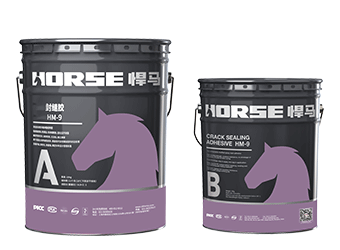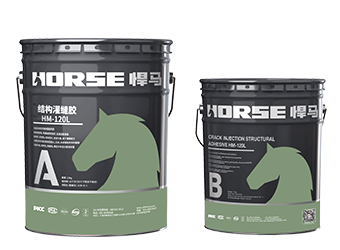Solutions
Horse Construction offers full range of structural strengthening materials with technical supports, documentation supports, products supports, project supports.
Analysis and Treatment of Building Cracks
Cracks are a common quality problem after the completion of new building structures. Compared with existing buildings, cracks in newly completed buildings are actually more common. This is because in the first few years of the house's use, if there is no crack, it will not occur in the later period, unless the surrounding conditions of the building foundation (such as a newly excavated foundation pit nearby) or the use function has changed. If cracks occur soon after the completion of the building, it is often attributed to problems such as the design or construction of the new building. However, in the reconstruction and reinforcement of existing buildings, there are inevitably problems such as crack reinforcement and treatment. The crack generation mechanism and treatment method are basically the same as those of new buildings, but there are also slight differences. This article makes a brief description of the generation and treatment of common building cracks, not only the problem of cracks in existing buildings, so this article is an outer part of this series of articles.
1: Analysis of the causes of building cracks
The appearance of cracks is generally caused by foundation settlement, temperature deformation, construction quality or design errors. Special attention should be paid to cracks that have a severe impact on structural stability and shear capacity. Because this kind of crack is different from the crack that affects the bending and tension of the structure, there is no obvious premonition for the structural stability and shear (through punching or punching) failure.
Cracks can be roughly divided into the following reasons:
1. The connection between the infill wall and the main structure is improperly handled, and the building surface measures are improper.
Such cracks generally do not have an impact on structural safety, but make people (non-professionals or professionals who have not identified the cause) first think whether there is structural safety, whether it is caused by foundation settlement or structural stress.
2. Cracks such as improper construction process.
It is generally caused by construction and maintenance, hydration heat of large-volume concrete, premature demoulding, poor pouring, concrete material ratio, alkali-aggregate reaction, and commercial mixing quality. For structural designers without on-site construction experience, these cracks may be irregular, but in fact they should be regular, probably only experts who are engaged in concrete research can tell. These cracks sometimes have no effect on the structural force, but have a greater impact on the durability of concrete, and should generally be treated.
3. Cracks caused by temperature. This is one of the main reasons for concrete cracks.
4. Cracks caused by foundation settlement.
Subsidence of foundation is one of the most important reasons for causing cracks in the rules. Such cracks have strong regularity, usually from the beginning of the building to a few years, and treatment measures should generally be taken.
5. The calculation model of structural design does not match the actual situation, and the layout plan of structural components is wrong.
This situation is also relatively common, such as point hinges of continuous secondary beams, torsion of edge beams, etc. Some cracks will cause internal force redistribution, which will not cause structural safety problems, but may not meet the requirements of normal use.
6. It does not meet the limit state of normal use.
In fact, this is not uncommon for normal design, because our specification still has enough security, unless there is a design error.
For different structures, the characteristics of cracks are different. Now we will briefly describe the cracks in brick-concrete structures and concrete structures.
Two: cracks in the brick-concrete structure
1. The figure-eight cracks on the top wall caused by the different thermal expansion coefficients of the roof concrete roof and brick masonry. Generally, expansion joints and increased roof insulation are used. This reason may also cause horizontal cracks at the junction of the roof parapet and the concrete roof, or it may be dislocated due to the water ingress and frost heave pushing the parapet.
2. Figure-eight or figure-eight cracks in the wall caused by foundation settlement or frost heave of foundation soil.
3. Cross cracks in the wall caused by the earthquake.
4. Vertical splitting cracks caused by insufficient compression of the masonry structure.
Three: cracks in reinforced concrete structures
Cracks in concrete structures can be divided into three categories.
The first type, cracks caused by external loads, are also called structural cracks. As we mentioned above, there are generally not many such cracks in normal design, because the load of the actual project is often less than the design load, unless the load is omitted.
The second type, cracks caused by deformation, are also called non-structural cracks. Such as cracks caused by temperature changes, concrete shrinkage, and uneven settlement of foundations. When this deformation is not satisfied, a self-stress is generated inside the structural member, and when the self-stress exceeds the allowable tensile stress of the concrete, cracks will occur.
Cracks caused by ultra-long structures are mainly caused by temperature, so the specification specifies the spacing of expansion joints. Now many new technologies such as expansion concrete, reinforcement belts and other measures can make the length of the concrete structure greatly exceed the length of the expansion joint required by the specification.
For residential commercial housing construction, we must be cautious, and try to set expansion joints according to the requirements of the specification. Because the probability of occurrence of concrete cracks is very large, if the design adopts an ultra-long structure, even if measures are taken, the occurrence of cracks may not be caused by the ultra-long structure. In the face of the doubts of many small owners, it is actually very difficult to prove this point, and it is easy to attribute the cracks to design problems. For general public buildings, everyone will analyze and deal with them rationally, so I think that non-commercial residential buildings can use super-long structures when there are reliable measures.
The third category is caused by the construction process, such as concrete ratio, materials such as alkali-aggregate reaction, poor vibrating compaction, maintenance, premature demoulding, etc.
Four: treatment measures to control cracks and cracks
The control of cracks is divided into design measures of construction drawings and structural construction completion acceptance. When cracks are found, analyze and take measures. Cracks in the structure generally belong to the design problems, temperature deformation and construction problems mentioned above. For existing buildings that have been in use for a long time, the problem of cracks is relatively less. Cracks in existing buildings may be caused by durability problems, changing the functional load of the building, brutal renovation and decoration without design, and changes in the surrounding environment of the building's genetics (such as water level, excavation of foundation pits next to it) caused by settlement.
This paper mainly introduces the treatment measures for cracks in existing buildings.
1. When cracks occur due to durability, or the durability of the structure is affected by cracks, the following measures should be taken:
For cracks caused by structural durability, first check whether the durability problem will cause problems with the stress of the structure. For example, whether the steel bar has been corroded to the extent that it needs to be reinforced, and if it affects the stress of the structure, the structure must be reinforced and the cracks must be treated.
For cracks that may affect the durability of the structure, crack sealing glue such as epoxy resin should be used for treatment.
2. Structural cracks caused by changing the building function without design and renovation are generally stress cracks. At this time, inspection and safety appraisal should be carried out, and the cracks should be reinforced according to the inspection and appraisal results and the cracks should be filled with crack repair glue.
3. For cracks caused by foundation settlement, the foundation shall be inspected and identified whether to be reinforced, and reinforcement and treatment measures shall be taken for structural cracks.
4. The main materials for crack treatment are: crack injection glue and crack injection slurry. Crack injection glue is divided into "pressure injection glue for crack sealing" and "pressure injection glue for crack repair", the two should not be confused. Crack sealers only serve to fill cracks, increase erosion resistance, and improve durability, while crack repair glues can serve to restore concrete strength. Therefore, the sealing glue can stick to the B-grade glue of carbon fiber according to the concrete base material, and the performance of the repair glue should be high, according to the provisions of the technical specifications for concrete reinforcement. When structural repair glue is used to repair the strength of concrete, it must be indicated on the structural drawings, and the strength of the repaired concrete shall be determined by drilling core samples after 7 days of age. Therefore, even if this kind of repair glue is used in practical engineering, the increase in its strength is not considered as a safety reserve.
You can find anything here you are in need of, have a trust trying on these products, you will find the big difference after that.

High strength, unidirectional carbon fiber wrap pre-saturated to form a carbon fiber reinforced polymer (CFRP) wrap used to strengthen structural concrete elements.

High strength crack sealing repairing adhesive for the fracture surface of concrete crack

Very strong penetration and low viscosity epoxy crack injection adhesive for repairing concrete crack